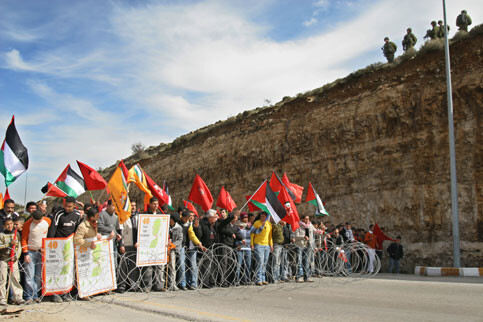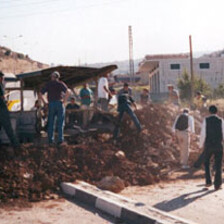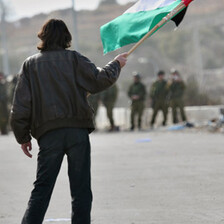The Electronic Intifada 2 March 2008

Palestinian protesters attend a demonstration marking the 38th anniversary of the Democratic Front for the Liberation of Palestine (DFLP) and against the Israeli wall in the West Bank village of al-Khader, 22 February 2008. (Luay Sababa/MaanImages)
For the last two months the residents of al-Khader have demonstrated every week against the illegal construction of the Israeli wall on their land. The demonstrations are organized by the al-Khader Popular Committee against the Wall and Settlements, with the support of al-Khader institutions, residents as well as Israeli and international activists. Al-Khader’s mayor, Ramzi Salah, said last week that the wall has a devastating effect on the village, effectively annexing 90 percent of its land. Two-thirds of the residents rely for their livelihood on farming. Although the Israeli forces have responded aggressively, it has not stopped the protesters from raising their voices. Every week they send a clear message to the world that they want an end to the construction of the wall and the settlements on Palestinian land.
The village of al-Khader is located four kilometers east of the internationally-recognized Green Line marking the boundary between Israel and the West Bank, and almost four kilometers west of the city of Bethlehem. In 2006 the Palestinian Central Bureau of Statistics counted 9,285 inhabitants in al-Khader and the total area within the boundaries of the village is 20,090 dunums (one dunum is 1,000 square meters).
On 4 September 2006, Israeli authorities issued a military order to confiscate 102.2 dunums of land belonging to the communities of al-Khader and the bordering village Artas in order to construct the wall east of the two villages. One year later the Israeli army distributed a new military order to confiscate another 321 dunums of land adjacent to Road 60, an exclusive, settler-only road, to build an additional two-kilometer wall section in al-Khader and Artas. The wall will not only cut off al-Khader villagers from almost all their land, the construction will also cause the demolition of Khirbe ‘Alia, a historical site of Roman ruins, with mosaic floors, aqueducts and carved rock tombs.
During the second demonstration that was held on Friday, 25 January, over 1,000 persons gathered at the main construction site of the wall near al-Khader. From there the protesters wanted to go to nearby settler Road 60 but Israeli soldiers blocked their way, shooting at the protesters with tear gas, sound grenades and rubber bullets. Nine people suffered breathing difficulties, and two children of 11 and 13 years old were injured by rubber bullets.
Two weeks later, 500 Palestinian demonstrators marched once again towards the construction site of the wall in al-Khader. It was the intention of the organizers to keep the march peaceful and to avoid a confrontation with the Israeli military. At least 30 heavily-armed Israeli soldiers and riot police had already blocked the road with barbed wire. Shortly after the arrival of the peaceful demonstrators, the soldiers fired tear gas and sound grenades in order to disperse the march. Two men were injured by sound grenades, including 60-year-old Khalil Salah, who was hospitalized. Three young children were wounded by tear gas canisters. As one of the organizers said, the Israeli soldiers “don’t even need an excuse” to start shooting. Dany, a 27-year-old Jewish Israeli from Tel Aviv, who joined the march with a group of Israelis, said, “we feel that what is happening is cruel and wrong.”
The nonviolent demonstrations gained momentum with more than 1,500 protesters participating in the demonstration on 22 February. Israeli forces confronted the march near the road to Efrat settlement, raining down rubber-coated steel bullets and noxious gas on the demonstrators. At least 70 persons were hurt by the aggressive Israeli armed response to the nonviolent march. Organizers reported to the Palestinian Maan News Agency that 43 persons, including 13 women and children, were admitted to a hospital after suffering tear gas inhalation. A further 18 people were hit by rubber bullets and taken to al-Yamameh Hospital. Three people, including two children, were seriously beaten and suffered severe bruising by Israeli soldiers while the latter tried to disperse the crowd. Doctor Mohamed Odeh of the Palestinian Medical Relief Society stated that two emergency medical personnel were injured as they tried to evacuate the injured people from the scene. The organization condemned the attack on the medical staff, noting that it is not the first time that members of their medical crews have come under Israeli attack in violation of international humanitarian law, which guarantees medical crews neutrality.
“Freedom and justice for Palestine, freedom and justice to all” is the slogan of the next demonstration. The demonstrations in al-Khader are steadfast and participants will continue their nonviolent resistance, but what would boost their cause would be the intervention of the international community to stop Israel from further violating the people of al-Khader’s rights.
Adri Nieuwhof is an independent consultant based in Switzerland, and Samer Jaber is the executive director of the Mithaq-Cultural Forum for Development and lives in al-Khader.
Related Links





